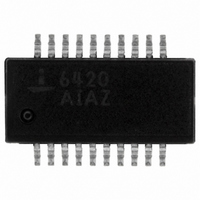ISL6420AIAZ-TK Intersil, ISL6420AIAZ-TK Datasheet - Page 17

ISL6420AIAZ-TK
Manufacturer Part Number
ISL6420AIAZ-TK
Description
IC CTRLR PWM SYNC BUCK 20-QSOP
Manufacturer
Intersil
Specifications of ISL6420AIAZ-TK
Pwm Type
Voltage Mode
Number Of Outputs
1
Frequency - Max
1.4MHz
Duty Cycle
100%
Voltage - Supply
4.5 V ~ 28 V
Buck
Yes
Boost
No
Flyback
No
Inverting
No
Doubler
No
Divider
No
Cuk
No
Isolated
No
Operating Temperature
-40°C ~ 85°C
Package / Case
20-QSOP
Frequency-max
1.4MHz
Lead Free Status / RoHS Status
Lead free / RoHS Compliant
Other names
ISL6420AIAZ-TKTR
Available stocks
Company
Part Number
Manufacturer
Quantity
Price
Company:
Part Number:
ISL6420AIAZ-TK
Manufacturer:
Intersil
Quantity:
2 400
case sizes. However, the equivalent series inductance (ESL)
of these capacitors increases with case size and can reduce
the usefulness of the capacitor to high slew-rate transient
loading. Unfortunately, ESL is not a specified parameter.
Work with your capacitor supplier and measure the
capacitor’s impedance with frequency to select a suitable
component. In most cases, multiple electrolytic capacitors of
small case size perform better than a single large case
capacitor.
Output Inductor Selection
The output inductor is selected to meet the output voltage
ripple requirements and minimize the converter’s response
time to the load transients. The inductor value determines
the converter’s ripple current and the ripple voltage is a
function of the ripple current and the output capacitors ESR.
The ripple voltage and current are approximated by the
following equations:
Increasing the value of inductance reduces the ripple current
and voltage. However, larger inductance values reduce the
converter’s response time to a load transient.
One of the parameters limiting the converter’s response to a
load transient is the time required to change the inductor
current. Given a sufficiently fast control loop design, the
ISL6420A will provide either 0% or 100% duty cycle in
response to a load transient. The response time is the time
required to slew the inductor current from an initial current
value to the transient current level. During this interval the
difference between the inductor current and the transient
current level must be supplied by the output capacitor.
Minimizing the response time can minimize the output
capacitance required.
The response time to a transient is different for the
application of load and the removal of load. The following
equations give the approximate response time interval for
application and removal of a transient load:
where: I
response time to the application of load, and t
response time to the removal of load. With a +5V input
source, the worst case response time can be either at the
application or removal of load and dependent upon the
output voltage setting. Be sure to check both of these
equations at the minimum and maximum output levels for
the worst case response time.
∆
∆
t
t
RISE
FALL
I
V
L
OUT
=
V
------------------------------- -
=
=
IN
TRAN
=
Fs x L
------------------------------- -
V
L
------------------------------ -
L
- V
O
∆
O
IN
I
V
×
×
L
OUT
–
OUT
⋅
I
I
V
TRAN
TRAN
is the transient load current step, t
ESR
OUT
⋅
V
--------------- -
V
OUT
IN
17
FALL
RISE
is the
(EQ. 10)
(EQ. 12)
(EQ. 13)
(EQ. 11)
is the
ISL6420A
Input Capacitor Selection
Use a mix of input bypass capacitors to control the voltage
overshoot across the MOSFETs. Use small ceramic
capacitors for high frequency decoupling and bulk capacitors
to supply the current needed each time Q1 turns on. Place the
small ceramic capacitors physically close to the MOSFETs
and between the drain of Q1 and the source of Q2.
The important parameters for the bulk input capacitor are the
voltage rating and the RMS current rating. For reliable
operation, select the bulk capacitor with voltage and current
ratings above the maximum input voltage and largest RMS
current required by the circuit. The capacitor voltage rating
should be at least 1.25 times greater than the maximum
input voltage and a voltage rating of 1.5 times is a
conservative guideline. The RMS current rating requirement
for the input capacitor of a buck regulator is approximately
1/2 the DC load current. A more specific equation for
determining the input ripple is the following,
For a through hole design, several electrolytic capacitors
(Panasonic HFQ series or Nichicon PL series or Sanyo
MV-GX or equivalent) may be needed. For surface mount
designs, solid tantalum capacitors can be used, but caution
must be exercised with regard to the capacitor surge current
rating. These capacitors must be capable of handling the
surge-current at power-up. The TPS series available from
AVX, and the 593D series from Sprague are both surge
current tested.
MOSFET Selection/Considerations
The ISL6420A requires 2 N-Channel power MOSFETs.
These should be selected based upon r
requirements, and thermal management requirements.
In high-current applications, the MOSFET power dissipation,
package selection and heatsink are the dominant design
factors. The power dissipation includes two loss
components; conduction loss and switching loss.
The conduction losses are the largest component of power
dissipation for both the upper and the lower MOSFETs.
These losses are distributed between the two MOSFETs
according to duty factor (see the equations below). Only the
upper MOSFET has switching losses, since the Schottky
rectifier clamps the switching node before the synchronous
rectifier turns on.
Where D is the duty cycle = Vo/Vin, t
interval, and f
I
P
P
RMS
UFET
LFET
=
=
=
I
MAX
I
I
2
O
2
O
⋅
⋅
R
R
SW
⋅
DS ON
DS ON
(
D D
is the switching frequency.
(
(
–
)
)
2
⋅
⋅
)
(
D
1 D
+
–
1
-- - I
2
)
O
⋅
V
IN
⋅
SW
t
sw
DS(ON)
⋅
is the switching
f
sw
, gate supply
October 13, 2005
(EQ. 14)
(EQ. 15)
(EQ. 16)
FN9169.1













